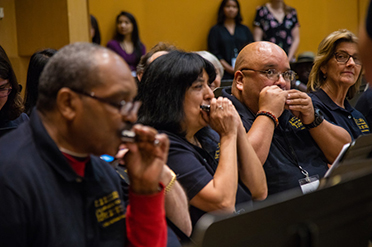Striking a New Note
- BY Cal State East Bay
- June 24, 2016

Once a week, a half-dozen people gather in Cal State East Bay's music building for harmonica lessons. But according to their instructors, the participants are getting far more out of it than just learning to play the instrument.
The group is the newest addition to the Aphasia Tones, a choir created in 2009 by Ellen Bernstein-Ellis, Cal State East Bay’s Aphasia Treatment Program director. It is comprised of individuals learning to live fully with aphasia, which occurs most commonly after a stroke or brain injury. Aphasia can affect one’s ability to speak and understand others, and can lead to difficulties with reading and writing. Despite not being able to speak in sentences, some individuals with aphasia can sing familiar songs, and that’s what the program at CSUEB focuses on — getting patients to find their voice through music.
“At the most basic level, it gives individuals with aphasia an opportunity to learn something new and feel successful while doing it — something that is not always easy to find for this population,” said Kasondra Gerth, a Cal State East Bay alumna who helped establish the program when she was a graduate student. “It also provides a sense of community and the group lessons themselves create a motivating environment to facilitate improvements with language deficits.”
The curriculum is specialized to meet the needs of individuals with aphasia using pictures, writing and gestures to communicate during the lessons. Gerth presented the harmonica project and the initial findings at the AphasiaAccess Conference in Boston in March 2015. She said it was well received, with multiple colleagues in the field requesting the curriculum.
“Because many persons with aphasia also have lost some strength or coordination in their right hand due to damage in the left hemisphere of the brain, harmonica is a good choice because it can be played with one hand,” said Xeno Rasmusson, harmonica instructor and assistant professor of human development & women’s studies. “Given the other set of demands involving breath control and the muscles of speech, it really seems like this is a great choice for personal development and may indeed turn out to be an effective intervention for regaining some language function.”
Bernstein-Ellis says there is research looking into how playing the harmonica may help those with pulmonary disease improve respiratory strength and oxygen saturation. However, in the stroke population, reports thus far have been anecdotal with patients often describing improvements in their quality of living through life participation.
“The most striking change I've noted has been the increase in confidence and sense of pride the members feel in learning a new skill,” Bernstein-Ellis said. “There is also the sense of joy they experience associated with making music. When they become successful at this brand new skill, it often improves their confidence in their ability to undertake new activities.”
June is National Aphasia Awareness Month. The national campaign, supported by groups like the National Aphasia Association and Aphasia Access, is meant to increase public education around the language disorder and to recognize the numerous people who are living with or caring for people with aphasia. Cal State East Bay’s Aphasia Treatment program was established in 1996 by Dr. Jan Avent, former chair of the Communicative Sciences and Disorders Department. Over the last two decades, it has been recognized for its Life Participation Approach, championed worldwide by leading speech language pathologists.
“Our department is fortunate to be home to a long-standing, university-based group treatment program for aphasia,” said Shubha Kashinath chair of communicative sciences and disorders. “Not only does it bring us national and international recognition, but it offers our students a one-of-a-kind training opportunity that sets them apart as they pursue careers in speech pathology.”
The Aphasia Tones is comprised of 25 members who rehearse weekly and perform three to six concerts a year for audiences ranging from 25 to more than 250 people. Each concert allows the members to be ambassadors in raising awareness about aphasia, which affects at least one million Americans according to the National Aphasia Association.